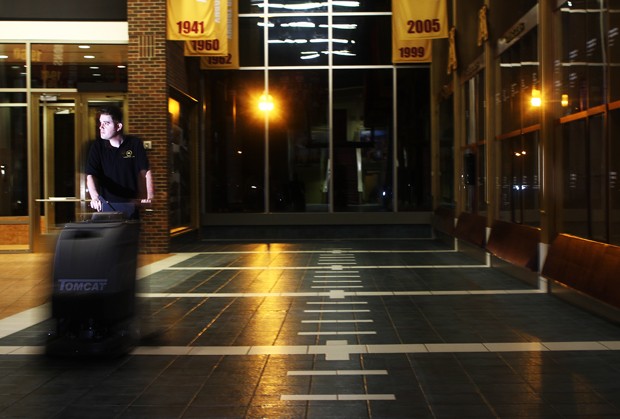After years of bouncing between jobs, 29-year-old Andy Wenkel thought he had found some job security doing custodial work at the University of Minnesota.
But the University hired Wenkel as a building/grounds maintenance worker in August 2008 on the verge of one of the biggest budget crunches in school history. Talks of layoffs began to surface last summer and Wenkel, who sat at the bottom of a 400-plus employee seniority ladder, began to worry.
“If they would’ve laid off just one person it would have been me,” he said. “In the back of my mind, there was always that chance that we might get laid off, and I don’t know how close we actually came to that, but there was always that possibility.”
Wenkel was safe, but only because in the spring of 2009, the Minnesota Legislature announced that $89.3 million from the American Recovery and Reinvestment Act, commonly called the federal stimulus bill, would be passed down to the University.
The University has since used the money to not only keep employees, but also to fund one-time projects and reduce tuition increases for in-state students.
On Thursday, the University will enter the final year of stimulus funding. The future could prove to be brutal on the University’s budget, because while stimulus funds have allowed it to evade large-scale layoffs and tuition hikes, it remains to be seen if the funds have successfully been used to avoid harsh realities or simply push them two years down the road.
Taming tuition
For University students, the most apparent effect of stimulus funding has been the cap on tuition increases for in-state undergraduate students.
Over the biennium, tuition rates for in-state undergrads have risen 15 percent, but because of the stimulus relief, those students paid only half, or 7.5 percent, of that increase.
If the trend of decreased state funding continues as expected, tuition may rise further. However, even if tuition rates remained the same, fall 2011 tuition would increase $744 to $11,094 in the absence of stimulus dollars.
In total, the University devoted 52 percent of the stimulus to offsetting tuition increases. The other 48 percent is funding one-time projects and grants delaying or avoiding layoffs.
State of employment
While the harsh reality of tuition increases is evident, the stimulus’ effect on jobs is less clear.
One use of the 48 percent of the stimulus “bridge pool” was to avoid firing employees for two years in hopes that jobs would open up as other employees retired or left, said the University’s Chief Financial Officer Richard Pfutzenreuter.
“The goal was that at the end of the day we wouldn’t have to lay people off, we could merge them into positions that became vacant,” Pfutzenreuter said. “That’s still a goal, but it may or may not happen. I think it is going to happen for some, but I don’t know if it will happen for everyone.”
It worked for Wenkel. Months after moving to a stimulus project crew, he was able to fill a full-time position that had been vacated. He now works the night shift, cleaning the Gibson-Nagurski Football Complex.
However, the University is hoping to repeat this success roughly 1,200 times. If that many positions cannot be opened or vacated, employees will be fired, Pfutzenreuter said.
In an effort to level its budget, University Services needed to cut 70 custodial positions.
Recent projections from all stimulus-receiving departments said at least 65 temporary jobs have been created and at least 245 jobs have been retained.
Stimulating coursework
Departments and colleges aren’t just using stimulus funding to keep faculty around.
University Services, for example, is using this time to restructure its budget through cost-saving solutions like picking up trash from offices every week rather than every day.
The University’s Institute of Technology, for example, received about $2.2 million in stimulus funds for fiscal year 2010 and used $1.4 million of it to add about 40 half-time teaching assistants that it had cut from its budget before the stimulus arrived. It invested about $750,000 to hire about 15 to 20 one-time contract faculty members.
The college did this to maintain course offerings, IT Dean Steven Crouch said.
“The good question is: What happens in 2011 and 2012?” Crouch asked. “We’ve been working with the departments for the last couple of years on this, asking them to try and position themselves so that we can reduce the reliance on TAs for some classes … getting ready for the reality that we won’t be getting as much money.”
Departments and colleges also used funding to jump-start programs and to conduct research.
The School of Dentistry, for example, received $750,000 to protect roughly a dozen faculty members, but also got $500,000 to begin a new Dental Therapy Program.
School of Dentistry Dean Patrick Lloyd said the new program is designed to train non-dentists on how to drill and fill teeth, and he expects it to continue long after stimulus money is gone.
The school has also received several different stimulus awards which have allowed it to create new positions and purchase new equipment, Sven Gorr, the Dental School’s associate dean of research, said.
Gorr is currently using a $75,000 stimulus grant to create an information database for the autoimmune disease Sjögren’s Syndrome.
So, while it may be years before the consequences of stimulus decisions are truly realized, there is a general consensus on the stimulus in the University committee: It was good while it lasted.
“To be honest, without this money, we would’ve probably had to cut the University’s budget another $50 to $60 million,” President Bob Bruininks said. “It would’ve been very, very painful.”

















